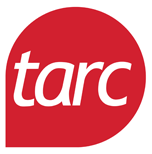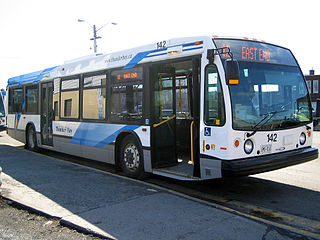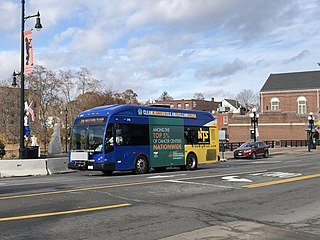
Night service, sometimes also known as owl service, is a mode of public transport service operated during the night hours. As an intermediate approach – between providing full service around the clock and stopping services altogether – it provides more limited service during times of lower passenger volume, saving resources and allowing for maintenance on primary transportation systems. They typically offer fewer routes and less frequent service. Night-based services may be differently branded compared to daytime services. Examples are London and Chicago, where overnight buses are prefixed with an "N" for "night". Another common way to distinguish night services from their daytime counterparts is dark-colored line numbers. Some cities apply a different fare structure for night services from their daytime services.

The Société de transport de Montréal is a public transport agency that operates transit bus and rapid transit services in the urban agglomeration of Montreal, Quebec, Canada. Established in 1861 as the "Montreal City Passenger Railway Company", it has grown to comprise four subway lines with a total of 68 stations, as well as 212 bus routes and 23 night routes. The STM was created in 2002 to replace the Société de transport de la communauté urbaine de Montréal. The STM operates the most heavily used urban mass transit system in Canada, and one of the most heavily used rapid transit systems in North America. As of 2019, the average daily ridership is 2,297,600 passengers: 977,400 by bus, 1,306,500 by rapid transit and 13,700 by paratransit service.

The Capital District Transportation Authority (CDTA) is a New York State public-benefit corporation overseeing a number of multi-modal parts of public transportation in the Capital District of New York State. CDTA runs local and express buses, including four lines of an express bus service called BusPlus, and day-to-day management of three Amtrak stations in the Capital region–the Albany-Rensselaer, Schenectady and Saratoga Springs Amtrak stations. In 2023, the system had a ridership of 15,779,000, or about 57,100 per weekday as of the second quarter of 2024.

The Transit Authority of River City (TARC) is the major public transportation provider for Louisville, Kentucky and parts of southern Indiana, including the suburbs of Clark County and Floyd County. TARC is publicly funded and absorbed private mass-transit companies in Louisville, the largest of which was the Louisville Transit Company. In 2023, the system had a ridership of 6,655,200.

Thunder Bay Transit is the public transit operator in Thunder Bay, Ontario, Canada. It was formed in 1970, after the amalgamation of the cities of Port Arthur and Fort William and their respective transit agencies. Thunder Bay Transit is a member of the Canadian Urban Transit Association.

The Eureka Transit Service is the city fixed-route bus system in Eureka, California. ETS operates four weekday routes between downtown Eureka, Bayshore Mall, Henderson Center, Myrtletown, Cutten, and Pine Hill. Three routes operate on Saturdays. Bus service in Eureka is provided under contract by the Humboldt Transit Authority.

Cities Area Transit (CAT) is the public transportation system in the neighboring cities of Grand Forks, North Dakota, and East Grand Forks, Minnesota. The scheduled transit bus routes are operated by the city of Grand Forks and service is provided to East Grand Forks through a cost-sharing agreement. Paratransit for those who are unable to use the regular bus under the ADA, and a service for seniors, are provided under contract by Grand Forks Taxi.

Lextran is a public transportation bus system serving Lexington, Kentucky. Lextran operates 25 bus routes throughout the city of Lexington. Buses converge at the Downtown Transit Center located at 220 East Vine Street. In 2023, the system had a ridership of 3,901,900, or about 11,500 per weekday as of the second quarter of 2024.

The South Bend Public Transportation Corporation is a municipal bus system that serves the cities of South Bend and Mishawaka, as well as the nearby suburbs of Notre Dame and Roseland, in the very north of the U.S. state of Indiana. It is the most recent incarnation of the South Bend Railway Company, a street railway company that was founded on May 25, 1885. Transpo receives funding from local, state and federal taxes. In 2023, the system had a ridership of 1,262,400, or about 5,100 per weekday as of the second quarter of 2024.

Nashua Transit System provides public transit services for the city of Nashua, New Hampshire, located just on the outskirts of suburban Boston. NTS, also known as CityBus, provides eleven scheduled bus routes to major city destinations, and Citylift operates the paratransit service. In 2004, Metro Magazine named NTS as "one of the 10 Most Improved Transit Systems" in the United States.
Interurban Trolley is an Elkhart County regional public bus service operated by the Michiana Area Council of Governments (MACOG). It was originally known as the BUS system. The system serves the city of Elkhart and neighboring Goshen, Osceola, Dunlap and Mishawaka. It is made up of five fixed routes that radiate from downtown Elkhart and an on-demand para-transit service that covers the same territory as the fixed routes. The name refers to the fact that the system serves several communities using vintage-trolley-style buses, evoking interurban trains that were common in United States during the early 20th century.

The City Line is a bus rapid transit (BRT) line in Spokane, Washington, United States, that opened on July 15, 2023. The 6-mile-long (9.7 km) route, which is operated by the Spokane Transit Authority, runs from Spokane's Browne's Addition neighborhood, through Downtown Spokane and the University District, including the WSU Health Sciences campus and Gonzaga University, before ending at the Spokane Community College campus in the Chief Garry Park neighborhood. The project budget as of 2023 was $92.2 million.
Pine Bluff Transit is the primary provider of mass transportation in Pine Bluff, Arkansas with eight routes serving the region. As of 2019, the system provided 60,572 rides over 16,038 annual vehicle revenue hours with 4 buses and 2 paratransit vehicles.
Intracity Transit is the primary provider of mass transportation in Hot Springs, Arkansas with three routes serving the region. As of 2019, the system provided 168,627 rides over 15,572 annual vehicle revenue hours with 3 buses and 1 paratransit vehicles.
ColumBUS is the primary provider of mass transportation in Columbus, Indiana with five routes serving the region. As of 2019, the system provided 228,818 rides over 30,234 annual vehicle revenue hours with 5 buses and 5 paratransit vehicles.
Cass Area Transit is the primary provider of mass transportation in Logansport, Indiana with one route serving the region. As of 2019, the system provided 148,423 rides over 71,225 annual vehicle revenue hours with 2 buses and 24 paratransit vehicles.
Marion Transit System (MTS) is the primary provider of mass transportation in Marion, Indiana, with five routes serving the region. As of 2019, the system provided 257,760 rides over 14,708 annual vehicle revenue hours with 5 buses and 1 paratransit vehicle.
Washington Transit System (WTS) is the primary provider of mass transportation in Washington, Indiana, with one bus route serving the region. As of 2019, the system provided 18,426 rides over 2,450 annual vehicle revenue hours with 1 bus.
Lawton Area Transit System, or LATS, is the primary provider of mass transportation in Lawton, Oklahoma with five routes serving the region. As of 2019, the system provided 346,742 rides over 43,108 annual vehicle revenue hours with 13 buses and 8 paratransit vehicles.
Central Community Transit (CCT) is the primary provider of mass transportation in Litchfield and Willmar, Minnesota with two routes serving the region in addition to countywide demand-response services. As of 2019, the system provided 227,429 rides over 51,272 annual vehicle revenue hours with 5 buses and 27 paratransit vehicles.










